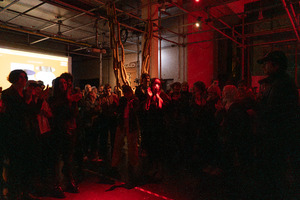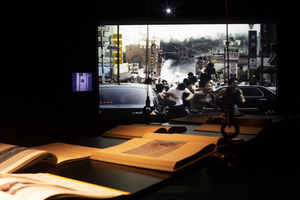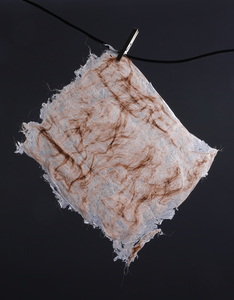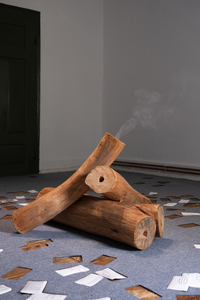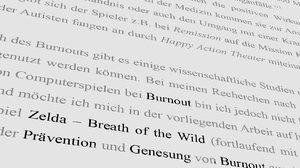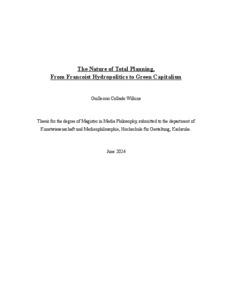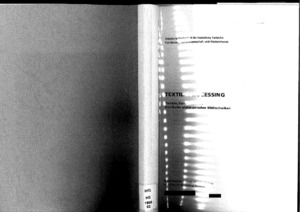Sets
272 Inhalte
- Seite 1 von 23
UMBAU Launch 3: Chaining
- Titel
- UMBAU Launch 3: Chaining
- Internetlinks
- Titel
- UMBAU Launch 3: Chaining
- Importiert am
- 15.01.2025
- Übergeordnete Sets
- 2
- Set enthält
- 0 25
UMBAU Issue 3 Celebration
- Titel
- UMBAU Issue 3 Celebration
- Autor/in
- Beschreibung (de)
- Thursday our HfG online Journal UMBAU will celebrate it's 3rd Issue called CHAINING.
8pm / 18.01.24 / at HfG Forum
There will be a performance by the artist Elle Fierce at 20:30 They are a Trans Non-Binary, British born Jamaican-Irish artist and activist, classically trained in ballet and modern dance, and have performed on stages around the world, particularly in the UK and most recently as a Soloist at Oper Leipzig. Now a freelance artist, with a multi disciplinary approach to performance, combining their activism and life experience as a black trans body to create provocative works.
The event shows artworks by Lucia Mattes and Lars Pinkwart and hosts afterwards DJ sets by aswesome LaLa Tina and our very best Frankie Spiderweb.
Our first contributions feature Mascha Dilger, Matteo Pasquinelli and Ülkü Süngün.
With unchained hearts, your UMBAU Team // Paolo Caffoni, Charlotte Eifler, Yannick Fritz, Jule Köpke & Livia Lazzarini
- Thursday our HfG online Journal UMBAU will celebrate it's 3rd Issue called CHAINING.
- Beschreibung (en)
- Thursday our HfG online Journal UMBAU will celebrate it's 3rd Issue called CHAINING.
8pm / 18.01.24 / at HfG Forum
There will be a performance by the artist Elle Fierce at 20:30 They are a Trans Non-Binary, British born Jamaican-Irish artist and activist, classically trained in ballet and modern dance, and have performed on stages around the world, particularly in the UK and most recently as a Soloist at Oper Leipzig. Now a freelance artist, with a multi disciplinary approach to performance, combining their activism and life experience as a black trans body to create provocative works.
The event shows artworks by Lucia Mattes and Lars Pinkwart and hosts afterwards DJ sets by aswesome LaLa Tina and our very best Frankie Spiderweb.
Our first contributions feature Mascha Dilger, Matteo Pasquinelli and Ülkü Süngün.
With unchained hearts, your UMBAU Team // Paolo Caffoni, Charlotte Eifler, Yannick Fritz, Jule Köpke & Livia Lazzarini
- Thursday our HfG online Journal UMBAU will celebrate it's 3rd Issue called CHAINING.
- Schlagworte
- Datierung
- 18.01.2024
- Mitwirkende
- Ort: Institution
- Ort
- HfG Forum
- Stadt
- Land
- Internetlinks
- Titel
- UMBAU Issue 3 Celebration
- Importiert am
- 20.02.2024
- Übergeordnete Sets
- 0
- Set enthält
- 0 25
UMBAU
- Titel
- UMBAU
- Autor/in
- Beschreibung (en)
- UMBAU is an online journal for the promotion of art, research, and design emerging from Karlsruhe University of Arts and Design (HfG).
In 1992, a time of major socio-economic and technological change, the Karlsruhe University of Arts and Design was founded as a “digital Bauhaus.” UMBAU, an architectural term roughly translatable as “remodeling” (to take a given structure and adjust it to contemporary situations) addresses this heritage and introduces a moment of destabilisation. UMBAU welcomes trans-disciplinary modes of thinking through the situational, the unfinished, and the transitional.
Through bi-weekly contributions from international artists, scientists, philosophers, historians and designers, UMBAU captures up-to-date research, while its annual editorial themes enable an in-depth exploration of ideas.
Concept by
Matthias Bruhn, Katharina Weinstock.
Founded by
Katharina Weinstock.
Founding members
Ariana Dongus, Friederike Schäfer, Katharina Weinstock.
- UMBAU is an online journal for the promotion of art, research, and design emerging from Karlsruhe University of Arts and Design (HfG).
- Kategorie
- Typ des Projekts/Werks
- Internetlinks
- Titel
- UMBAU
- Importiert am
- 13.02.2025
- Übergeordnete Sets
- 1
- Set enthält
- 1 0
TOWER POWER
- Titel
- TOWER POWER
- Autor/in
- Beschreibung (de)
- TOWER POWER ist eine performative Untersuchung der architektonischen Formensprache und Symbolik des Torre Fiat in Marina di Massa, Italien - dem Ausstellungsort des POST-COLONIA Festival of Architecture and Imaginaries in Transition.
Als in Architektur materialisierte Ideologie steht der Turm scheinbar unausweichlich für eine lineare, gewaltvolle Erzählung von Geschichte. Mithilfe von Ursula K. Le Guins „Carrier Bag Theory of Fiction“ (1986) befragt TOWER POWER die dem Turm eingeschriebenen Narrative und den Umgang mit einem derart aufgeladenen baulichen Erbe.
- TOWER POWER ist eine performative Untersuchung der architektonischen Formensprache und Symbolik des Torre Fiat in Marina di Massa, Italien - dem Ausstellungsort des POST-COLONIA Festival of Architecture and Imaginaries in Transition.
- Beschreibung (en)
- TOWER POWER is a performative investigation of the formal language and architectural symbolism of the Torre Fiat in Marina di Massa, Italy - the venue of POST-COLONIA Festival of Architecture and Imaginaries in Transition we had been invited to explore and exhibit in.
Steeped in ideology, the tower’s architecture inescapably seems to stand for a linear, violent historiography. TOWER POWER investigates the narratives inscribed into the tower through the lens of Ursula K. Le Guin’s Carrier Bag Theory of Fiction and poses questions on how to deal with such a charged architectural legacy.
- TOWER POWER is a performative investigation of the formal language and architectural symbolism of the Torre Fiat in Marina di Massa, Italy - the venue of POST-COLONIA Festival of Architecture and Imaginaries in Transition we had been invited to explore and exhibit in.
- Kategorie
- Typ des Projekts/Werks
- Datierung
- 2025
- Mitwirkende
- Dank an
- Sprache
- Dauer
- 12 Minuten
- Titel
- TOWER POWER
- Importiert am
- 27.06.2025
- Übergeordnete Sets
- 0
- Set enthält
- 0 0
Tide
- Titel
- Tide
- Titel (en)
- Tide
- Autor/in
- Beschreibung (de)
- Gezeiten sind dem Zyklus von Sonne, Erde und Mond unterworfen. Sie sind die Bewegung der Wassermassen des Ozeans, die an den Küsten als periodisches Ansteigen und Absinken des Meeresspiegels in Erscheinung tritt. [...] Gezeiten als Daseinsmetapher umreißen das fortlaufende Ausbalancieren von Kommen und Gehen, Anziehen und Abstoßen, Sich zeigen und entziehen. [...] "Tide" überträgt dieses Verständnis der Gezeiten in eine kontinuierliche, non-lineare Bewegung im Ausstellungsraum.
- Beschreibung (en)
- Tides are subject to the cycle of the sun, earth and moon. They are the movement of the water masses of the ocean, which appears on the coasts as a periodic rise and fall of the sea level. [...] Tides as a metaphor for existence outline the continuous balancing of coming and going, attracting and repelling, showing and withdrawing. [...] "Tide" translates this understanding of the tides into a continuous, non-linear movement in the exhibition space.
- Kategorie
- Schlagworte
- Datierung
- 01.07.2020 - 05.07.2020
- Dank an
- Francesca Audretsch
- Patrick Alan Banfield
- Lisa Bergmann
- Matthias Bruhn
- Anja Casser
- Hans Christ (Hans D. Christ)
- Jaya Demmer
- Hubert Distel
- Anja Dorn
- Lizzy Ellbrück
- Hanna Franke
- Christoph Funk
- Laurine Haller
- Maria Harder-Scheib
- Sascha Jungbauer
- Lydia Kähny
- Tobias Keilbach
- Iden Sungyoung Kim
- Alexander Knoppik
- Hanne König
- Susanne Kriemann
- Judith Milz
- Paulina Mimberg
- Andrej Mircev
- Andreas Müller
- Viktor Neumann
- Leonie Ohlow
- Jonas Piroth
- Anja Ruschival
- Thomas Rustemeyer
- Friederike Schäfer
- Sebastian Schäfer
- Ivo Scheib
- Corinna Scheib
- Karl-Heinz Scheib
- Josefine Scheu
- Hendrik Stoerk
- Lioudmila Voropai
- Leia Morgana Walz
- Petra Zimmermann
- Ort: Institution
- Ort
- Großes Studio
- Stadt
- Land
- Titel
- Tide
- Projektleiter/in
- Semester
- Studiengang
- Typ der Abschlussarbeit
- Importiert am
- 14.06.2024
- Übergeordnete Sets
- 1
- Set enthält
- 0 15
Thinking inside out
- Titel
- Thinking inside out
- Titel (en)
- Thinking inside out
- Untertitel
- ZKM & HfG Gesprächsreihe
- Untertitel des Projekts/Werks (en)
- HfG & ZKM Talk Series
- Autor/in
- Beschreibung (de)
- In der Vortragsreihe »thinking inside out« laden das ZKM und die HfG Karlsruhe dazu ein, den Blick über vertraute Grenzen hinaus zu wagen. Internationale Stimmen aus Philosophie, Literatur und Kunst treffen hier auf Studierende, Forschende, Kulturschaffende und interessierte Bürger:innen – für inspirierende Begegnungen, unerwartete Perspektiven und offene Diskussionen.
- Beschreibung (en)
- As part of the lecture series »thinking inside out«, ZKM and HfG Karlsruhe invite audiences to look beyond familiar boundaries. International voices from philosophy, literature, and the arts come together with students, researchers, cultural practitioners, and engaged members of the public—for inspiring encounters, unexpected perspectives, and open dialogue.
- Typ des Projekts/Werks
- Mitwirkende
- Ort: Institution
- Titel
- Thinking inside out
- Importiert am
- 13.05.2025
- Übergeordnete Sets
- 1
- Set enthält
- 1 0
There are Biocomposites Growing in My Garden
- Titel
- There are Biocomposites Growing in My Garden
- Titel (en)
- There are Biocomposites Growing in My Garden
- Beschreibung (de)
- Für das Eröffnungsfestival von Driving the Human am 20.–22.11.2020 trug das Bio Design Lab neben dem Panel-Programm mit dem Remote-Workshop „There are Biocomposites Growing in my Garden“ einen tragenden Programmpunkt bei. Vorab wurde hierzu in Zusammenarbeit mit dem ZKM ein Trailer produziert, welcher das Lab, sowie dessen Beteiligung an der ZKM Ausstellung „Critical Zones“, bisherige Aktivitäten und Materialien vorstellte und zur Eröffnung des Streaming-Festivals am Freitagabend gezeigt wurde. Anschließend ermöglichte ein technisches Set-Up mit mehreren Kameras einen Remote-Workshop, der das Panel-Programm des Festivals von Samstag bis Sonntag als Hands-On-Komponente ergänzte. Als Workshop-Leiter konnte hierfür Kim André Lange gewonnen werden. Der Alumni der HfG Karlsruhe, der bereits eine umfassende Recherche zu Bioplastik in seinen bisherigen Arbeiten vorweisen konnte, führte via Stream durch die zwei Tage. Offen für alle Interessierten, gab es so jeweils am Morgen eine einstündige Lecture, in der die Historie und materialtechnische Aspekte zu Bioplastik sowie dessen aktuelle Entwicklung und Einsatzbereiche vorgestellt wurden. Darauf folgte freies Experimentieren und Betreuung durch das Bio Design Lab Team mit Ina Grabosch und Julia Ihls. Da ein Arbeiten on-site Corona-bedingt allerdings nicht möglich war, mussten einige alternative Lösungen zur Umsetzung erdacht werden: So wurde im Vorfeld eine Einkaufsliste mit benötigten Materialien und Utensilien auf der ZKM- und BDL-Website kommuniziert. Während des Workshops begleitete ein Social Media Team die Arbeiten im Lab via Instagram auf den BioDesignLab und Driving The Human Kanälen. Entsprechend konnten die internationalen Teilnehmer dem Workshop-Programm live folgen, Fragen stellen und auch ihre eigenen Workshop-Ergebnisse mit der DtH-Community teilen. Den Abschluss des zweitägigen Programms bot eine Live-Q&A auf dem Bio Design Lab Instagram-Kanal. Hier diskutierten Grabosch, Ihls und Lange den Nutzen und die Grenzen des Bio-Materials, gaben Einblicke in die Workshop-Erzeugnisse und beantworteten offene Fragen der Community.
- Für das Eröffnungsfestival von Driving the Human am 20.–22.11.2020 trug das Bio Design Lab neben dem Panel-Programm mit dem Remote-Workshop „There are Biocomposites Growing in my Garden“ einen tragenden Programmpunkt bei. Vorab wurde hierzu in Zusammenarbeit mit dem ZKM ein Trailer produziert, welcher das Lab, sowie dessen Beteiligung an der ZKM Ausstellung „Critical Zones“, bisherige Aktivitäten und Materialien vorstellte und zur Eröffnung des Streaming-Festivals am Freitagabend gezeigt wurde. Anschließend ermöglichte ein technisches Set-Up mit mehreren Kameras einen Remote-Workshop, der das Panel-Programm des Festivals von Samstag bis Sonntag als Hands-On-Komponente ergänzte. Als Workshop-Leiter konnte hierfür Kim André Lange gewonnen werden. Der Alumni der HfG Karlsruhe, der bereits eine umfassende Recherche zu Bioplastik in seinen bisherigen Arbeiten vorweisen konnte, führte via Stream durch die zwei Tage. Offen für alle Interessierten, gab es so jeweils am Morgen eine einstündige Lecture, in der die Historie und materialtechnische Aspekte zu Bioplastik sowie dessen aktuelle Entwicklung und Einsatzbereiche vorgestellt wurden. Darauf folgte freies Experimentieren und Betreuung durch das Bio Design Lab Team mit Ina Grabosch und Julia Ihls. Da ein Arbeiten on-site Corona-bedingt allerdings nicht möglich war, mussten einige alternative Lösungen zur Umsetzung erdacht werden: So wurde im Vorfeld eine Einkaufsliste mit benötigten Materialien und Utensilien auf der ZKM- und BDL-Website kommuniziert. Während des Workshops begleitete ein Social Media Team die Arbeiten im Lab via Instagram auf den BioDesignLab und Driving The Human Kanälen. Entsprechend konnten die internationalen Teilnehmer dem Workshop-Programm live folgen, Fragen stellen und auch ihre eigenen Workshop-Ergebnisse mit der DtH-Community teilen. Den Abschluss des zweitägigen Programms bot eine Live-Q&A auf dem Bio Design Lab Instagram-Kanal. Hier diskutierten Grabosch, Ihls und Lange den Nutzen und die Grenzen des Bio-Materials, gaben Einblicke in die Workshop-Erzeugnisse und beantworteten offene Fragen der Community.
- Beschreibung (en)
- For the opening festival of Driving the Human on 20-22.11.2020, the Bio Design Lab contributed to the panel program and the remote workshop "There are Biocomposites Growing in my Garden". In advance, a trailer was produced in collaboration with the ZKM, which introduced the Lab and its participation in the ZKM exhibition "Critical Zones", previous activities and materials, and was shown at the opening of the streaming festival on Friday evening. Afterwards, a technical set-up with several cameras enabled a remote workshop that complemented the festival's panel program from Saturday to Sunday as a hands-on component. Kim André Lange was recruited to lead the workshop. The alumnus of the HfG Karlsruhe, who has already done extensive research on bioplastics in his previous work, led through the two days via stream. Open to all interested parties, there was a one-hour lecture in the morning in which the history and material-technical aspects of bioplastics as well as their current development and areas of application were presented. This was followed by free experimentation and supervision by the Bio Design Lab team with Ina Grabosch and Julia Ihls. Since it was not possible to work on-site at Corona, however, some alternative solutions had to be devised for implementation: For example, a shopping list of required materials and utensils was communicated in advance on the ZKM and BDL websites. During the workshop, a social media team accompanied the work in the lab via Instagram on the BioDesignLab and Driving The Human channels. Accordingly, international participants were able to follow the workshop program live, ask questions and also share their own workshop results with the DtH community. The two-day program concluded with a live Q&A on the Bio Design Lab Instagram channel. Here, Grabosch, Ihls and Lange discussed the benefits and limitations of biomaterials, provided insights into workshop deliverables and answered open questions from the community.
- Typ des Projekts/Werks
- Schlagworte
- Datierung
- 20.11.2020 - 22.11.2020
- Mitwirkende
- Material
- Ort: Institution
- Ort
- Bio Design Lab
- Stadt
- Land
- Beteiligte Institution(en)
- Titel
- There are Biocomposites Growing in My Garden
- Projektleiter/in
- Semester
- Importiert am
- 25.10.2023
- Übergeordnete Sets
- 1
- Set enthält
- 0 21
The Plenum – A Scripted Play
- Titel
- The Plenum – A Scripted Play
- Autor/in
- Beschreibung (de)
- "The Plenum – A Scripted Play" behandelt das performative, das rituelle und das gemeinschaftsbildende Moment des Plenums als Planungstreffen selbstverwalteter Gruppen im politischen und kulturellen Kontext.
Über den Zeitraum eines Jahres wurden "Plena" in unterschiedlichen Konstellationen durchgeführt, die die gruppeneigene Dynamik untersuchten und auf Basis eines sich verändernden Scripts, einem Theaterdrehbuch oder Code gleichend, in einer kollektiven Performance Ausdruck fanden.
Die dabei von der Gruppe gemachten Erfahrungen dienten nicht nur zur Dokumentation für Gewesenes, sondern wurden als neuer „Input“ sofort in das bestehende Script eingearbeitet. Das sich permanent verändernde Projekt konnte so nach Vorbild eines Computerprogramms transparent gestaltet werden und ermöglichte eine basisdemokratische Beteiligung aller Akteur:innen – unabhängig von präexistentem Wissen oder Erfahrungswerten.
Nach Vorbild von Jo Freemans Essay „The Tyranny Of Structurelessness“ stand das Schaffen offener und klarer Kommunikation bezüglich der eigenen Gruppenstruktur und deren „Balance of Power“ im Mittelpunkt der Treffen.
„The Plenum – A Scripted Play“ ist jedoch nicht nur ein reales Treffen einer politischen Gruppe, sondern schafft seine identitäre Notwendigkeit durch seine Schnittstelle mit der Simulation: Das Finden von Mehrheiten (oder Einstimmigkeiten), die Verteilung von Macht und Autorität innerhalb der eigenen Gruppe sowie der Entscheidungsfindungsprozess wurden in verschiedenen Modellen spielerisch erprobt und in ihren politischen und historischen Kontext eingeordnet. Der fiktive Aspekt der Treffen öffnete Spielräume zur Reflexion über das eigene Verhalten innerhalb von Gruppengefügen. Vielen dieser Simulationen dienten Computercodes, Brettspiele und politische Verfassungen zur Vorlage.
Einem jeden Treffen selbstverwalteter Gruppen wohnt immer – oft unbewusst – etwas Rituelles inne, das zum Schaffen der kollektiven Identität von hoher Bedeutung ist. Das Wiederholen planerischer Abläufe und die kodifizierten, gruppenspezifischen Kommunikationsregeln entscheiden über Zugehörigkeit zur Gruppe und sind identitäts- und sinnstiftend.
Was vom Plenum bleibt, sind Simulationsskizzen, ein (beinahe) gegründeter Verein, eine intensive Auseinandersetzung um Vergütungsmodelle in einer nonmonetären Mikrowirtschaft und das Erarbeiten nachhaltiger Strukturen für die eigene kulturelle und politische Praxis, die sich bis heute fortsetzen. Sichtbar von alledem ist nichts, außer die Spuren, die wir stigmergisch hinterlassen.
Diese Spuren: Der Raum, in dem wir uns treffen; das Feuer, um das wir uns versammeln; die Karten, aus denen wir ablesen können, was einmal besprochen wurde – und werden wird; und das Script, ein sich permanent veränderndes Programm, das es uns vielleicht einmal ermöglichen wird, eine sozial und ökologisch nachhaltige Existenz in der Kunst- und Kulturszene zu führen.
- "The Plenum – A Scripted Play" behandelt das performative, das rituelle und das gemeinschaftsbildende Moment des Plenums als Planungstreffen selbstverwalteter Gruppen im politischen und kulturellen Kontext.
- Beschreibung (en)
- "The Plenum - A Scripted Play" deals with the performative, ritual and community-building moment of the plenum as a planning meeting of self-organised groups in a political and cultural context.
Over the course of a year, "Plena" were held in different constellations, which examined the group's own dynamics and found expression in a collective performance based on a changing script, similar to a theatre script or code.
The experiences made by the group not only served to document what had already happened, but were also immediately incorporated into the existing script as new "input". The constantly changing project could thus be designed transparently, modelled like a computer program, and enabled the grassroots democratic participation of all actors - regardless of pre-existing knowledge or experience.
Inspired by Jo Freeman's essay "The Tyranny Of Structurelessness", the creation of open and clear communication regarding the group's own structure and its "balance of power" was at the centre of the meetings.
However, "The Plenum – A Scripted Play" is not just a real meeting of a political group, but creates its identitary necessity through its intersection with the simulation: finding majorities (or unanimity), the distribution of power and authority within one's own group and the decision-making process were playfully tested in various models and placed in their political and historical context. The fictitious aspect of the meetings opened up scope for reflection on one's own behaviour within group structures. Many of these simulations were based on computer codes, board games and political constitutions.
There is always – often unconsciously – something of ritual inherent to every meeting of self-governed groups, which is of great importance for creating a collective sense of identity. The repetition of planning processes and the codified, group-specific communication rules determine membership of the group and create identity and purpose.
What remains of the plenum are simulation sketches, an (almost) founded association, an intensive debate about remuneration models in a non-monetary micro-economy and the development of sustainable structures for one's own cultural and political practice, which continue to this day. None of this is visible, except for the traces that we stigmergically leave behind.
These traces: the space in which we meet; the fire around which we gather; the cards from which we can read what has been – and will be – discussed; and the script, a constantly changing programme that will perhaps one day enable us to lead a socially and ecologically sustainable existence in the world of art and culture.
- "The Plenum - A Scripted Play" deals with the performative, ritual and community-building moment of the plenum as a planning meeting of self-organised groups in a political and cultural context.
- Kategorie
- Typ des Projekts/Werks
- Datierung
- 07.03.2023 - 18.04.2024
- Sprache
- Ort
- Plenarwohnung, Atelier von K.-J. Overkott, Günther-Klotz-Anlage, Schlosspark, Stephanienstraße (bei Sven), Sophienstraße (bei Tim), auf dem Dach, ßpace.
- Stadt
- Land
- Titel
- The Plenum – A Scripted Play
- Projektleiter/in
- Studiengang
- Typ der Abschlussarbeit
- Importiert am
- 16.06.2024
- Übergeordnete Sets
- 1
- Set enthält
- 0 6
Theorie
- Titel
- Theorie
- Autor/in
- Titel
- Theorie
- Importiert am
- 20.12.2018
- Übergeordnete Sets
- 1
- Set enthält
- 0 3
The Nature of Total Planning
- Titel
- The Nature of Total Planning
- Titel (en)
- The Nature of Total Planning
- Untertitel
- From Francoist Hydropolitics to Green Capitalism
- Untertitel des Projekts/Werks (en)
- From Francoist Hydropolitics to Green Capitalism
- Autor/in
- Beschreibung (en)
- To what extent is sustainable development truly sustainable? In which ways is it different from previous ecological regimes, such as the extractivist practices of XXth century authoritarianisms? How do plans, and models, mediate between different temporalities? What can we learn about our social metabolism by studying climate scenarios as political techniques of government?
'The Nature of Total Planning' tries to answer these question by doing a close reading of the environmental history of La Bizkaia, a godforsaken valley in northern Spain. Historicising La Bizkaia’s social metabolism is the first step for a political and epistemological critique of green capitalism. A broader investigation of Francoist hydropolitics contextualises the pine monoculture as part of a national programme to enrol nature into Franco’s political project. The last section of this thesis compares that model with how La Bizkaia is managed today, under the sustainable development paradigm. While, discursively, sustainable development distances itself from the extractivist practices of fascist autarky, 'The Nature of Total Planning' reveals striking continuities in the material practices of La Bizkaia’s forestry management.
- To what extent is sustainable development truly sustainable? In which ways is it different from previous ecological regimes, such as the extractivist practices of XXth century authoritarianisms? How do plans, and models, mediate between different temporalities? What can we learn about our social metabolism by studying climate scenarios as political techniques of government?
- Kategorie
- Typ des Projekts/Werks
- Schlagworte
- Datierung
- 06.06.2024
- Mitwirkende
- Dank an
- Boris Buden
- Nagore Chivite Lizarraga
- Ariana Dongus
- Christian Egerer
- Víctor Fancelli Capdevila
- Max Grünberg
- Sami Khatib
- Jule Köpke
- Barbara Kuon
- Livia Lazzarini
- Iñigo Mazkiaran
- Matteo Pasquinelli
- César Alonso Porras
- Juan José Recalde
- Jess Saxby
- Valentin Schwarz
- Mariana Silva
- Ionel Spanachi
- Iñigo Villafranca Apesteguía
- Lioudmila Voropai
- Sprache
- Ort: Institution
- Stadt
- Land
- Beteiligte Institution(en)
- Internetlinks
- Titel
- The Nature of Total Planning
- Projektleiter/in
- Studiengang
- Typ der Abschlussarbeit
- Importiert am
- 22.10.2024
- Übergeordnete Sets
- 0
- Set enthält
- 0 1
Textile Processing
- Titel
- Textile Processing
- Untertitel
- Punkte, Zeilen, Spalten; Vorläufer elektronischer Bildtechniken
- Autor/in
- Beschreibung (de)
- “Die Ähnlichkeiten von Geweben, Mustervorlagen und heutigen Rasterbildern sind eklatant. In einer Genese der technischen Bilder kann das Gewebe als Exemplarfall und Vorreiter aller technisch-elektronischer Bilder gelten.”
“Die ersten Bilder, die von ihrem Bildkörper abgelöst wurden, bestanden aus einem Stapel gelochter Karten für die Verwendung im Jacquardwebstuhl. Der Bildcode ist hier noch begreifbar, das Bild, wenn es aus dem Stapel dieser Karten gewoben wird, ein textil-taktiles Produkt. Patricia Wallers Needle-Works zeigen die Leerstelle heutiger Bildmaschinen auf, wo Bilder auf Monitoren erscheinen, um im nächsten Moment schon wieder durch den nächsten (Netzhaut-) Eindruck ausgetauscht zu werden.”
- “Die Ähnlichkeiten von Geweben, Mustervorlagen und heutigen Rasterbildern sind eklatant. In einer Genese der technischen Bilder kann das Gewebe als Exemplarfall und Vorreiter aller technisch-elektronischer Bilder gelten.”
- Beschreibung (en)
- “The similarities between fabrics, patterns and today's raster images are striking. In the genesis of technical images, the fabric can be regarded as an exemplary case and forerunner of all technical-electronic images.”
“The first images that were detached from their image body consisted of a stack of perforated cards for use in the Jacquard loom. The image code is still comprehensible here, the image, when woven from the pile of these cards, is a textile-tactile product. Patricia Waller's needle works show the blank space of today's image machines, where images appear on monitors only to be replaced by the next (retinal) impression in the very next moment.”
- “The similarities between fabrics, patterns and today's raster images are striking. In the genesis of technical images, the fabric can be regarded as an exemplary case and forerunner of all technical-electronic images.”
- Kategorie
- Typ des Projekts/Werks
- Schlagworte
- Datierung
- 02.11.1998
- Sprache
- Ort: Institution
- Stadt
- Titel
- Textile Processing
- Projektleiter/in
- Semester
- Studiengang
- Typ der Abschlussarbeit
- Archiv-Signatur
- HfG HS 1998 02
- Externes Archiv
- Importiert am
- 11.01.2024
- Übergeordnete Sets
- 0
- Set enthält
- 0 2
Testzentrum für chronischen Automobilismus
- Titel
- Testzentrum für chronischen Automobilismus
- Autor/in
- Beschreibung (de)
- Radweg Ende, kein Zebrastreifen, Parkplatz voll, Bahn verpasst and stop and go, jemand hupt alle schauen, rote Ampel niemand da, falsch abgebogen, Licht vergessen, vollgas Lichthupe, Überholmaneuver trotz Geschwindigkeitsbegrenzung, ups! Personenschaden, Spiegel abgebrochen, Fenster runter „Arschloch!“, selber! Brumm. Kennen Sie das?
Verkehr ist eine höchst emotionale Angelegenheit. Die vielen kleinen Entscheidungen, die wir im automobilen Individualverkehr treffen müssen, sind immer auch mit einem Risiko behaftet. Sehen wir den "Personenschaden" als Katastrophe an, so müssen wir doch zugeben, dass auch die kleinen Fehlentscheidungen für Stress, Frust und Wut sorgen können. Ebendiese Reaktionen möchten wir im Kontext der sogenannten Mobilitätswende anerkennen, attestieren und aus ihnen Forderungen ableiten, die wir gerne für unsere Besucher*innen an die lokalen Behörden weiterleiten.
Auto, Fahrrad, Zufuß? Egal! Unsere 20-minütige Erstuntersuchung richtet sich an alle Verkehrsteilnehmer*innen. Erfahren Sie fachkundige Beratung und die Anwendung neuester Technologie. Tipp: Buchen Sie schon jetzt einen Termin und vermeiden Sie Wartezeiten. Wir freuen uns auf ihren Besuch!
- Radweg Ende, kein Zebrastreifen, Parkplatz voll, Bahn verpasst and stop and go, jemand hupt alle schauen, rote Ampel niemand da, falsch abgebogen, Licht vergessen, vollgas Lichthupe, Überholmaneuver trotz Geschwindigkeitsbegrenzung, ups! Personenschaden, Spiegel abgebrochen, Fenster runter „Arschloch!“, selber! Brumm. Kennen Sie das?
- Kategorie
- Typ des Projekts/Werks
- Schlagworte
- Datierung
- 25.03.2024 - 28.03.2024
- Mitwirkende
- Sprache
- Material
- Technik/Verfahren/Formate
- GameMaker Studio 2 (Game)
- Abmessungen
- 5 x 7,5 m
- Dauer
- 25 Minuten (Erstuntersuchung)
- Ort: Institution
- Stadt
- Land
- Internetlinks
- Bemerkungen
- Dank an: Alexander Knoppik, Alexander Thelen, Anna Haas (Badisches Staatstheater), Astrid Lindner-Maier, Barbara Kuon, Charlotte Singer, Christian Platz, Cornelia Herzog, Daniel Heiss (ZKM), Dario Schmid, Emelie Schreiner, Felix Fisgus, Franzi Wentz, Isabelle Schneider, Julian Kuf, Laura Richter, Leonie Mühlen, Martin Mangold (ZKM), Marvin Uhde (cant-deci.de), Max Bernhard, Miri, Omni-Mobil GmbH, Paula Schacke (die Anstoss e.V.), Pavel Polenz, Ralph Saam (Scheck-In Center Durlach), Richard Brunner, Sebastian Schäfer, Sebastian Schillbach, Sebastian Schönfeld, Silke Roth (die Anstoss e.V.), Susanne Henneberger (WERKRAUM: Karlsruhe e.V.), Susanne Schmitt, Sven Krahl, Timothée Charon, Tobias Keilbach, Tjark Schönfeld, Ute Wienberg (Badisches Staatstheater), Vlado Petrovic, Waldemar Schwab, Yun-Wen Liu
- Dank an: Alexander Knoppik, Alexander Thelen, Anna Haas (Badisches Staatstheater), Astrid Lindner-Maier, Barbara Kuon, Charlotte Singer, Christian Platz, Cornelia Herzog, Daniel Heiss (ZKM), Dario Schmid, Emelie Schreiner, Felix Fisgus, Franzi Wentz, Isabelle Schneider, Julian Kuf, Laura Richter, Leonie Mühlen, Martin Mangold (ZKM), Marvin Uhde (cant-deci.de), Max Bernhard, Miri, Omni-Mobil GmbH, Paula Schacke (die Anstoss e.V.), Pavel Polenz, Ralph Saam (Scheck-In Center Durlach), Richard Brunner, Sebastian Schäfer, Sebastian Schillbach, Sebastian Schönfeld, Silke Roth (die Anstoss e.V.), Susanne Henneberger (WERKRAUM: Karlsruhe e.V.), Susanne Schmitt, Sven Krahl, Timothée Charon, Tobias Keilbach, Tjark Schönfeld, Ute Wienberg (Badisches Staatstheater), Vlado Petrovic, Waldemar Schwab, Yun-Wen Liu
- Titel
- Testzentrum für chronischen Automobilismus
- Projektleiter/in
- Semester
- Studiengang
- Typ der Abschlussarbeit
- Importiert am
- 31.05.2024
- Übergeordnete Sets
- 1
- Set enthält
- 0 0
